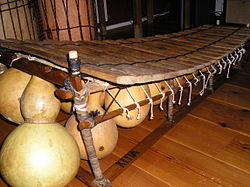Balafon

A fixed-key balafon, showing resonators with membrane holes.
|
|
| Other names | balafo, bala, balaphone, balaphon, balaphong, balani, gyil, balangi |
|---|---|
| Classification | West African wooden Percussion idiophone with up to 21 keys |
| Hornbostel–Sachs classification | 111.212 (Sets of percussion sticks) |
| Related instruments | |
| marimba, xylophone | |
| Musicians | |
| N'Faly Kouyate | |
| Builders | |
|
|
|
The balafon is a kind of wooden xylophone or percussion idiophone which plays melodic tunes, and usually has between 16 and 27 keys. It has been played in Africa since the 14th century; it originated in Mali, according to the Manding history narrated by the griots.
Believed to have been developed independently of the Southern African and South American instruments now called the marimba, oral histories of the balafon date it to at least the rise of the Mali Empire in the 12th century CE. Balafon is a Manding name, but variations exist across West Africa, including the balangi in Sierra Leone and the gyil of the Dagara, Lobi and Gurunsi from Ghana, Burkina Faso and Ivory Coast. Similar instruments are played in parts of Central Africa, with the ancient Kingdom of Kongo denoting the instrument as palaku.
Records of the balafon go back to at least the 12th century CE. In 1352 CE, Moroccan traveller Ibn Battuta reported the existence of the ngoni and balafon at the court of Malian ruler Mansa Musa.
European visitors to West Africa described balafons in the 17th century largely identical to the modern instrument. The Atlantic Slave Trade brought some balafon players to the Americas. The Virginia Gazette records African-Americans playing a barrafoo in 1776, which appears to be a balafon. Other North American references to these instruments die out by the mid-19th century.
...
Wikipedia
